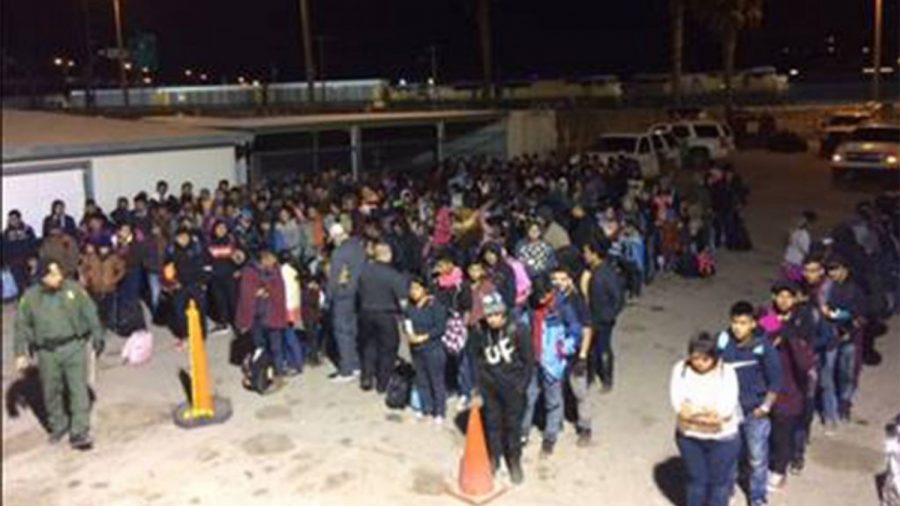President Donald Trump on March 29 warned that he would close the Southern Border “next week” if Mexico does not stop the massive number of illegal immigrants from entering the United States. He also criticized Democrats for not wanting to fix the country’s weak immigration laws.
“We have right now two big caravans coming up from Guatemala—massive caravans, walking right through Mexico,” Trump told reporters. “So Mexico’s tough, they can stop them, but they chose not to … They don’t do anything to stop it right now.”
Trump reiterated his stance on Twitter the next day.
“Mexico must use its very strong immigration laws to stop the many thousands of people trying to get into the USA,” he wrote. “Our detention areas are maxed out & we will take no more illegals. Next step is to close the Border! This will also help us with stopping the Drug flow from Mexico!”
Mexico must use its very strong immigration laws to stop the many thousands of people trying to get into the USA. Our detention areas are maxed out & we will take no more illegals. Next step is to close the Border! This will also help us with stopping the Drug flow from Mexico!
— Donald J. Trump (@realDonaldTrump) March 30, 2019
U.S. Customs and Border Protection (CBP) Commissioner Kevin McAleenan said at a press conference on March 27 that the border’s breaking point has arrived. He said that CBP is on pace to reaching 100,000 apprehensions and encounters in March, with 90 percent of immigrants crossing the border illegally. Trump stated on Twitter that Congress must change the weak immigration laws Democrats have given the country.
Fixing the Broken System
“Changes in the law and closing the vulnerabilities in our legal framework is the only way that this flow is going to be reduced and we’re going to be able to restore integrity to our immigration system,” said McAleenan during the press conference.
"In the last 4 days, we’ve seen fevers of 105 degrees in infants, a 2yo suffering from seizures in the desert, a 19yo with a congenital heart defect that needs emergency surgery, and a 40yo man suffering from multi-organ failure but trying to refuse medical care." @CBP_McAleenan pic.twitter.com/WWpBAJihrs
— CharlotteCuthbertson (@charlottecuthbo) March 27, 2019
Two-thirds of the influx are families and children, who claim asylum after entering CPB facilities and are then be released into the interior, regardless of their case’s merit. According to McAleenan, the courts tell CBP that only 10 to 15 percent of Central Americans have legitimate cases, with most of the rest claiming asylum for economic reasons—reasons not eligible for asylum.
The government also needs to overcome a court decision that has blocked the government from keeping families with children in detention.
“We need to be able to detain families together for a short period of time, 4–8 weeks to go through an immigration court proceeding,” McAleenan said. “If they don’t have a valid claim, we’ll repatriate. If they do, they’ll be released with certainty that they have asylum, with the ability [to] plan, to invest in a business, to make choices for schools. Right now they don’t have that. They live with uncertainty for years at a time because the system is broken and overwhelmed.”
#BorderPatrol in Rio Grande Valley Sector apprehended nearly 1,700 illegal aliens on March 26—the highest one-day total since 2014. @CBPRGV pic.twitter.com/hHmXL8gWdr
— CharlotteCuthbertson (@charlottecuthbo) March 29, 2019
Returning Children to Central America
He said the Trafficking Victims Protection Reauthorization Act of 2005 needs to change to allow the return of children to countries that don’t share a border with the United States. The Act prohibited this due to human trafficking concerns.
"We actually don't know who they are. So far, here in south Texas, we’ve apprehended folks from 44 different countries. These are from the Middle East, Southeast Asia, Yemen, Iraq, Pakistan, Iran, you name it.”
—Deputy Chief #BorderPatrol Agent Raul Ortiz @CBPRGV @rgv3307 pic.twitter.com/qJTHpSz4SI
— CharlotteCuthbertson (@charlottecuthbo) March 27, 2019
“For unaccompanied children, we have government partners in the Northern Triangle—El Salvador, Guatemala, Honduras—who are ready to take children back and handle that humanely,” McAleenan said. “Those are their citizens they believe they have a responsibility for and we’re not allowed to do that under the law, under the Trafficking Victims Protection Reauthorization Act.”
Update on new migrant caravan c/o my Guatemalan journalist buddy: now 2,500 in Chiapas State en route to Mexico City. Salvadorans, Cubans, Hondurans, Guatemalans. No Middle Easterners or Africans. About 500 children. Unclear which part of US border they’ll hit. Photo of last one: pic.twitter.com/FIKus3rPv9
— Todd Bensman (@BensmanTodd) March 27, 2019
Great work by our HSI special agents! ICE is tasked with tracking and removing gang members, like those belonging to MS-13. Read how our agents were able to stop these men before it was too late: https://t.co/qGVa3tqKIv
— ICE (@ICEgov) March 26, 2019
Epoch Times reporter Petr Svab contributed to this report.


